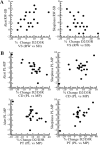Evidence that sleep deprivation downregulates dopamine D2R in ventral striatum in the human brain
- PMID: 22573693
- PMCID: PMC3433285
- DOI: 10.1523/JNEUROSCI.0045-12.2012
Evidence that sleep deprivation downregulates dopamine D2R in ventral striatum in the human brain
Abstract
Dopamine D2 receptors are involved with wakefulness, but their role in the decreased alertness associated with sleep deprivation is unclear. We had shown that sleep deprivation reduced dopamine D2/D3 receptor availability (measured with PET and [(11)C]raclopride in controls) in striatum, but could not determine whether this reflected dopamine increases ([(11)C]raclopride competes with dopamine for D2/D3 receptor binding) or receptor downregulation. To clarify this, we compared the dopamine increases induced by methylphenidate (a drug that increases dopamine by blocking dopamine transporters) during sleep deprivation versus rested sleep, with the assumption that methylphenidate's effects would be greater if, indeed, dopamine release was increased during sleep deprivation. We scanned 20 controls with [(11)C]raclopride after rested sleep and after 1 night of sleep deprivation; both after placebo and after methylphenidate. We corroborated a decrease in D2/D3 receptor availability in the ventral striatum with sleep deprivation (compared with rested sleep) that was associated with reduced alertness and increased sleepiness. However, the dopamine increases induced by methylphenidate (measured as decreases in D2/D3 receptor availability compared with placebo) did not differ between rested sleep and sleep deprivation, and were associated with the increased alertness and reduced sleepiness when methylphenidate was administered after sleep deprivation. Similar findings were obtained by microdialysis in rodents subjected to 1 night of paradoxical sleep deprivation. These findings are consistent with a downregulation of D2/D3 receptors in ventral striatum with sleep deprivation that may contribute to the associated decreased wakefulness and also corroborate an enhancement of D2 receptor signaling in the arousing effects of methylphenidate in humans.
Figures




References
-
- Arnulf I, Konofal E, Merino-Andreu M, Houeto JL, Mesnage V, Welter ML, Lacomblez L, Golmard JL, Derenne JP, Agid Y. Parkinson's disease and sleepiness: an integral part of PD. Neurology. 2002;58:1019–1024. - PubMed
-
- Baldessarini RJ. Drugs and the treatment of psychiatric disorders: depression and anxiety disorders. In: Goodman Gilman AG, Rail TW, Nies AS, Taylor P, editors. Goodman and Gilmans's the pharmacological basis of therapeutics. New York: Pergamon; 1990. pp. 447–484.
-
- Biaggioni I, Paul S, Puckett A, Arzubiaga C. Caffeine and theophylline as adenosine receptor antagonists in humans. J Pharmacol Exp Ther. 1991;258:588–593. - PubMed
-
- Borroto-Escuela DO, Romero-Fernandez W, Tarakanov AO, Ciruela F, Agnati LF, Fuxe K. On the existence of a possible A2A-D2-beta-Arrestin2 complex: A2A agonist modulation of D2 agonist-induced beta-arrestin2 recruitment. J Mol Biol. 2011;406:687–699. - PubMed
Publication types
MeSH terms
Substances
Grants and funding
LinkOut - more resources
Full Text Sources
